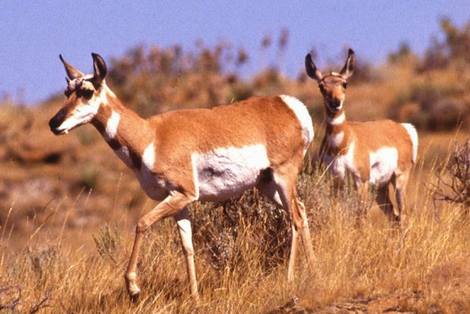
Texas’ pronghorn numbers are on the decline. Texas Parks and Wildlife Department (TPWD) wildlife biologists recently recorded a considerable drop in the pronghorn antelope population in portions of Jeff Davis and Presidio Counties, although they said overall pronghorn populations in the Trans-Pecos remain only slightly below the 30-year average.
Department biologists annually conduct aerial surveys in June and July throughout West Texas to count pronghorn herds. The resulting data is used to monitor populations and generate harvest quotas for hunting permits issued to private landowners. While conducting surveys this year, biologists noticed significantly fewer animals in certain areas than in previous years.
Subsequent ground-based efforts, including rancher interviews, indicated that there had been a fairly extensive loss of adult pronghorn in the affected counties. Though it is difficult to determine exactly how many individuals might have perished, mortality estimates approach 50 percent of adult pronghorn in the two counties, or in excess of 1,000 animals from more than 500,000 acres of desert grassland habitat.
Biologists said that for some landowners in the affected counties, the mortalities could reduce the number of pronghorn hunting permits issued this fall, but long-term effects will depend on future habitat conditions.
Wildlife disease experts were consulted, but examination of specimens did not indicate an obvious culprit for the mortalities. The specific causes for the loss are not known, but biologists believe several compounding factors probably triggered it.
Much of the affected area received no measurable rainfall for more than seven months from November 2007 to June 2008. The resulting severe range conditions can be especially stressful on pronghorn since they depend on green weedy plants for nutrition, and their ability to move to improved forage conditions is often limited by barriers.
Also, in late spring, a very uncharacteristic hard freeze took place at the higher elevations of West Texas. The drought and late freeze placed the animals in very poor physical condition, and almost certainly prompted the death of adult pronghorn, either to starvation, disease, or ingestion of toxic plants. Additionally, animals in this weakened state are much more prone to predation, and some adults likely were killed by coyotes and bobcats.
Much of the area has received substantial moisture this summer and most of the remaining pronghorn appear to have recovered and are in good physical condition. However, decreased pronghorn reproduction the last two years has amplified the situation, and provided very few replacement animals for these herds.
Pronghorn managers are encouraged to visit with their local TPWD biologist to discuss practices that might mitigate these losses. To find a local wildlife biologist in the Trans-Pecos region, call the Wildlife Division regional office in Alpine at (432) 837-2051.